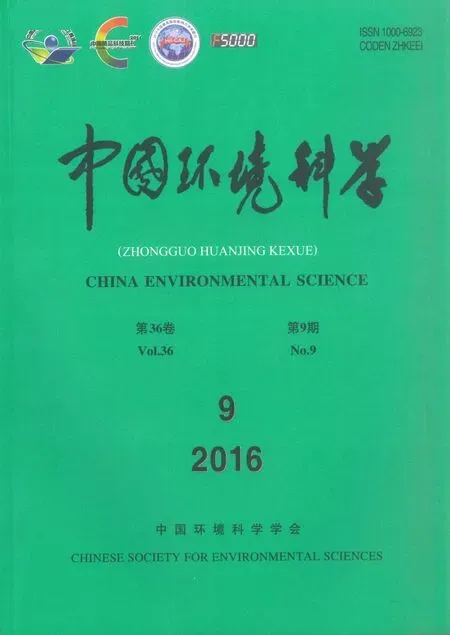雌激素在地下环境中的归宿及其生态调控
2016-12-01宋晓明杨悦锁温玉娟Adeel王园园杨新瑶沈阳大学区域污染环境生态修复教育部重点实验室辽宁沈阳0044吉林大学环境与资源学院吉林长春3002
宋晓明,杨悦锁,2*,温玉娟, M. Adeel,王园园,杨新瑶(.沈阳大学,区域污染环境生态修复教育部重点实验室,辽宁 沈阳 0044;2.吉林大学环境与资源学院,吉林 长春 3002)
雌激素在地下环境中的归宿及其生态调控
宋晓明1,杨悦锁1,2*,温玉娟1, M. Adeel1,王园园1,杨新瑶1(1.沈阳大学,区域污染环境生态修复教育部重点实验室,辽宁 沈阳 110044;2.吉林大学环境与资源学院,吉林 长春 130021)
综述了环境中典型的结合态与游离态类固醇雌激素的来源、危害以及环境归趋,探讨了其在地下环境(土壤和浅层地下水系统)中的吸附、微生物降解等迁移转化过程及其影响因素,总结了常见的环境雌激素处理方法与危害控制措施.最后,针对目前环境中类固醇雌激素在包气带与浅层地下水中的穿透过程及其生态效应研究工作的基础上,对未来相关方面的研究进行了展望.
类固醇雌激素;地下环境;吸附;微生物降解;迁移转化
类固醇雌激素(SEs)作为一类典型的内分泌干扰物,具有极强的内分泌干扰作用,产生的生态环境影响也尤为显著[1],SEs对土壤与地下水系统的生态效应也成为国内外的研究热点.研究表明,环境中的SEs约90%来源于畜禽粪便[2].集约化畜禽养殖业中大量使用促生长激素与畜禽自身生理代谢将产生大量SEs[3],而集约化、设备化农牧畜业生产方式进一步促使 SEs进入土壤与水环境.中国作为畜禽养殖业第一大国,每年将近40亿 t的畜禽粪便被施用到土壤进而释放到环境中[4],造成的土壤与水环境功能的改变、生态环境风险和人体健康风险不言而喻.本文总结了国内外关于SEs的最新研究进展,深入探讨SEs的种类、排放特征与危害,并详细阐述其在土壤与地下水系统中的环境行为及控制措施,为进一步认识SEs在包气带与浅层地下水中的穿透机制、开发高效低耗的控制和修复技术提供科学依据.
1 环境中的类固醇雌激素
1.1 类固醇雌激素的种类
天然环境中的 SEs根据其结构可分为游离态(Free)和结合态(Conjugate).其中最具代表性的包括雌酮(E1)、雌二醇(17α-E2、17β-E2)、雌三醇(E3)和乙炔基雌二醇(17α-EE2、17β-EE2).虽然人与动物排泄的雌激素主要为雌激素活性较低的结合态,但环境中的微生物能够将其水解转化为游离态而重现雌激素活性[5],游离态雌激素也可与硫酸根或葡萄糖苷酸通过酯化作用生成结合态.常见SEs的化学性质见表1[6-7].

表1 典型类固醇雌激素化学性质Table 1 Chemical properties of the typical SEs
1.2 环境中类固醇雌激素的来源与归趋
SEs一般通过人畜排泄物进入环境.对比人畜排放特征可见(表2),畜禽的排放显著高于人类,成为环境中SEs的主要来源[8-9].不同类型畜禽在不同生长阶段SEs排放量不同.通常孕期或妊娠阶段排放量显著高于正常生长期;牛和猪排泄雌激素的量一般高于羊、鸡等.不同畜禽排放的SEs种类也有明显差异,牛主要排放 17α-E2,而猪和家禽主要排放17β-E2,据此可以作为不同SEs来源的指示剂[10].一般人畜粪便中的SEs主要以游离态存在,而在尿液中主要为结合态[2].一些研究表明,人畜排放的SEs多以结合态为主,可达SEs总排放量的95%[11],而游离态中有相当一部分来自结合态的水解[12-13].Hoffmann等[14]研究牛的SEs排放形态发现,其体内SEs主要以E1-3S和17β-E2-3G形式存在,在排出的尿液中含量较高.虽然人畜排泄的 SEs以雌激素活性较低的结合态为主,但其在环境中易被微生物水解为游离态而产生内分泌干扰作用,且其溶解度更大,迁移性更强、带来的长期污染效应更严重.
人畜排放的 SEs可以通过多种方式进入环境,并在不同的环境介质间进行迁移转化.目前在国内外各种水体、畜禽粪浆、污水处理厂、河流沉积物、土壤等环境介质中已频繁检出(表3).污水处理厂是人畜排泄物的重要接纳场所之一.通常污水处理厂进水中 SEs含量一般为几~几百ng/L,且与其它环境样品相比,EE2的含量较高.对比污水厂进出水可以看出,大部分SEs能在污水处理系统中被去除,但出水中仍然可能含有SEs.
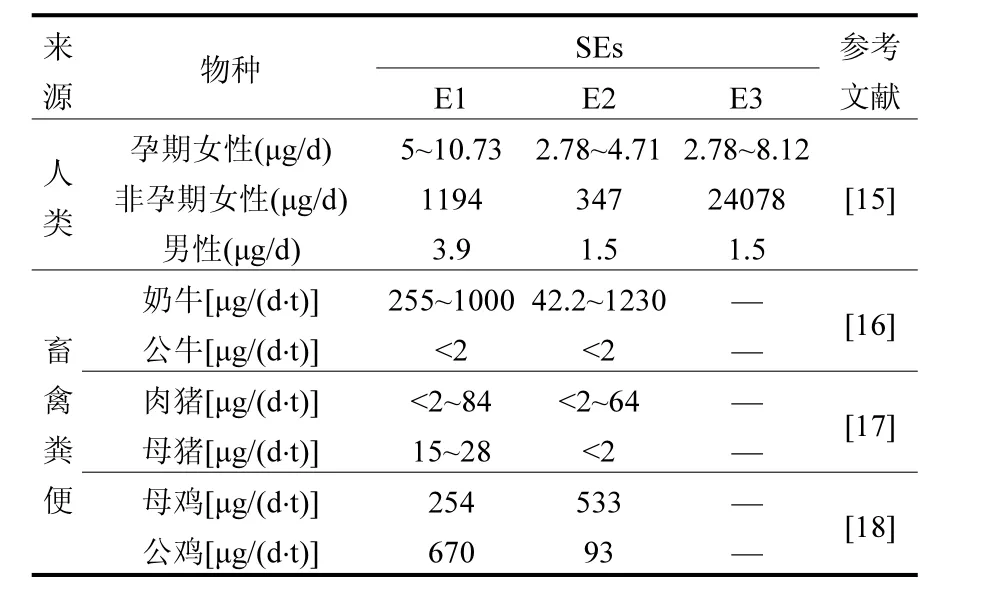
表2 人畜SEs排放特征对比Table 2 Comparison of SEs releases between human and livestock
畜禽养殖场是SEs的另一个重要来源,从表3可以看出,由于畜禽种类、养殖规模、粪便处理方式、以及检测方法的不同,养殖场(氧化塘)废水中的SEs含量差异很大,但均以E1、E2形式存在, E3与EE2很少检出.相对于污水处理厂,畜禽养殖废水的SEs含量更高.地表水体作为污水厂出水的直接受体,也一定程度上受到的 Ses的潜在危害.例如,Kolpin等[19]对美国30个州的139处地表水进行了详细调查取样,约40%的水体不同程度的受到SEs污染;Tabata等[20]人对日本100余条河流中的SEs进行调查,发现近80%的河水样品中均检测到 SEs.因此,如果利用含有SEs的河水进行灌溉,将使SEs进入农田系统并进一步迁移.此外,利用畜禽粪便进行施肥的集约化绿色农业也是土壤中 SEs的主要来源,粪便中大部分SEs会被降雨与灌溉水淋洗,重新随地表径流进入地表水体[21-22],剩余的SEs一部分透过土壤包气带进入地下水[23],其他另一部分则残留在包气带中.也有研究在饮用水中检测到SEs. Kuch等[24]在德国某些饮用水中检测E1和E2的浓度分别为0.2~0.6和0.2~2.1ng/L. Roefer等[25]也在饮用水水源中检测到了 E2,其浓度约为2.6ng/L.虽然饮用水中SEs浓度很低,但足以产生内分泌干扰作用.可见,SEs可以在各环境要素之间迁移、并对生态造成威胁(图1),这也为评价其环境风险,预测其环境归趋提出了新的挑战.
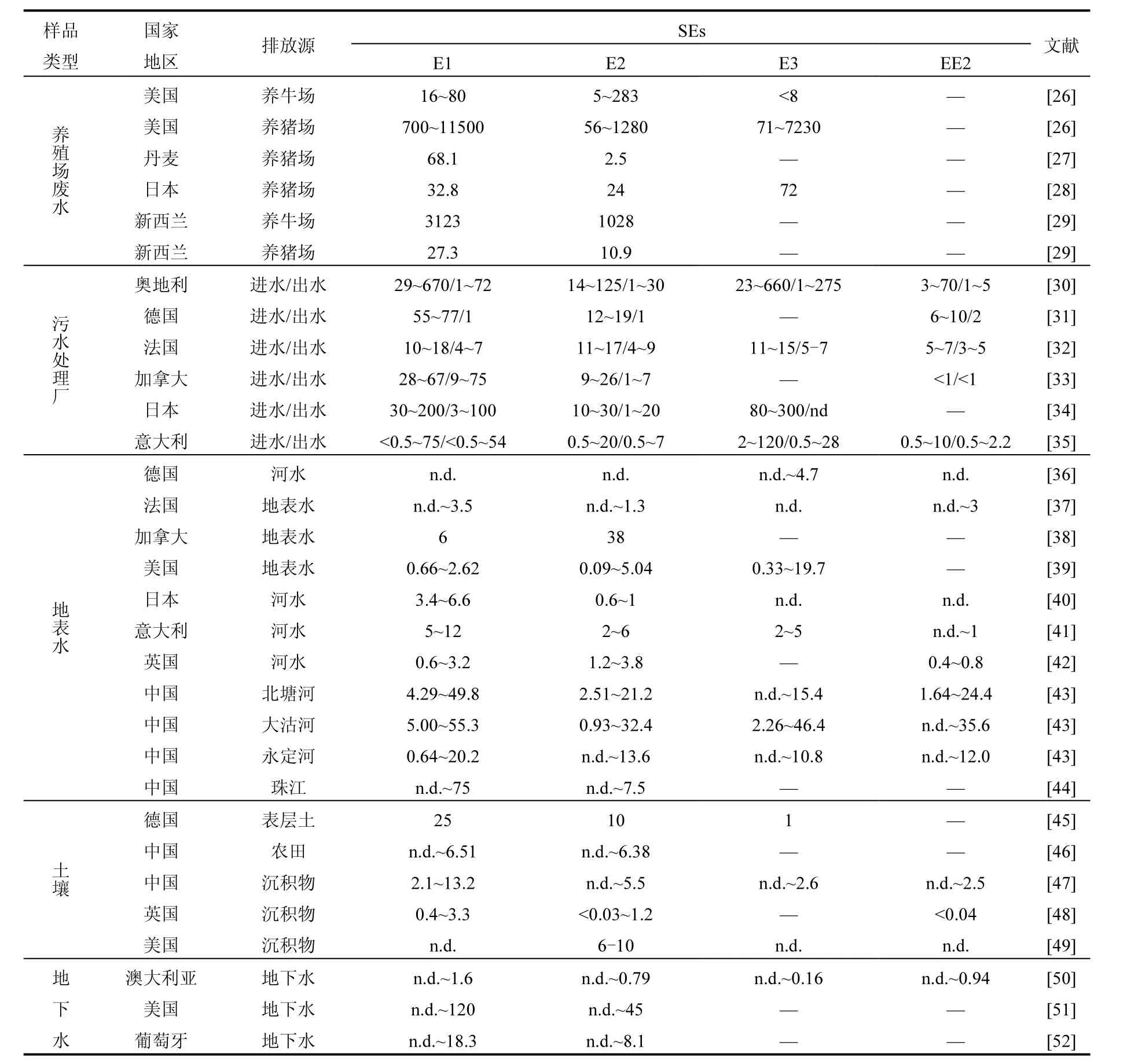
表3 不同环境样品中SEs浓度分布特征Table 3 The concentrations of SEs in various environmental samples
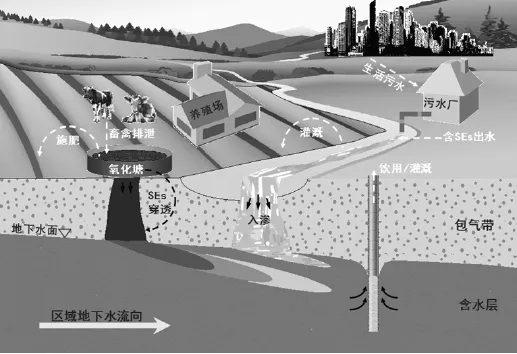
图1 环境中SEs迁移及其生态效应概念模型Fig 1 The conceptual model of transport and ecological effect of SEs in environment
1.3 类固醇雌激素的危害
SEs的危害多以水生生物为主,水体中极低的浓度(1ng/L)就会影响水生生物体内正常内分泌代谢[53].SEs最常见的危害效应是导致生物个体雌性化,在许多哺乳类生物中都已经发现了因SEs暴露而导致雄性个体体内出现卵黄蛋白原或雌性化器官的现象[54].Biegel等[55]研究证实,长期暴露于E2可以使雄性虹鳄鱼的斑纹转变为雌性斑纹,且生殖活动也向雌性特点转变. Korsgaard等[56]在研究英国某接受工厂排污河流中石斑鱼的生长发育特征时发现,约 60%的雄鱼出现了雌性化特征,两性鱼与雌性鱼比例明显增高,而这一现象的产生与水体中 EE2的含量增高显著相关.其次SEs对生长发育、生殖健康和生物繁衍的影响亦尤为显著.Biegel等[55]发现一定剂量的E2暴露可以造成小鼠卵巢和睾丸的发育异常,也会造成鸟类和鱼类生殖系统的发育畸形.除了影响生殖系统发育之外,雌激素暴露还会干扰生物体生殖系统的正常功能.Angus等[32]发现长期暴露于SEs会造成小鼠卵巢和睾丸的功能障碍导致卵泡减少、精子数量减少和精子活性降低,降低鸟类繁殖成功率,延迟鸟类产卵时间,以及干扰鱼类产卵.戴璇颖等[57]调查了我国北京、上海、天津等地上万名男性生殖健康状况发现,从 1981~1996年,该地区男性精液量、精子数目、精子活动率指标分别下降了10.0%、18.6%和10.4%,该变化不可能是遗传因素引起的,毫无疑问与环境中雌激素增多相关.此外,高浓度的暴露还会对生物体产生致癌或致畸变效应,如提高乳腺癌、睾丸癌、卵巢癌和子宫内膜瘤等发病概率[58];也有研究发现高浓度雌激素暴露可以导致幼鱼的死亡率增加[32].除了对生长发育、生殖系统影响较大之外,SEs也在许多其他方面对生物体产生影响,例如,生物体的免疫系统在SEs长期作用下会发生免疫失调和病理反应;过量 SEs暴露也能够对生物体的神经系统产生侵害,从而影响大脑皮层,下丘脑,脑垂体等对激素分泌的调节作用,导致激素合成、释放异常[59].值得注意的是,SEs可通过生物富集、空气吸入和皮肤接触等多种途径侵入人体,而且 SEs对人体健康的影响并不只局限于受暴露的个体本身,在一定的条件下具有遗传效应.
2 类固醇雌激素对土壤与地下水环境的胁迫
针对 SEs对地下环境(土壤与地下水)的潜在危害研究可追溯到20世纪90年代末,Ternes等
[60]研究发现SEs可通过地表水与排污管道泄漏迁移至地下水,进而对土壤与浅层地下水造成潜在危害. Peterson等[23]检测到某喀什特地区地下水中17β-E2含量达65ng/L,通过污染源分析最终确定主要来源于畜禽粪便污染.Wicks等[61]也发现在地表水与地下水交互频繁地区,地下水中17β-E2的浓度为达80ng/L,且其含量与地表水中17β-E2含量有显著相关性.Labadie等[62]最先开展了SEs在河底沉积物中垂直迁移的原位实验,发现沉积物底部界面上的E为表层沉积物的9倍,从而证实了SEs可以穿透到地下含水层系统,及其迁移过程中的界面效应.可见,尽管土壤对SEs具有较好的吸附性,但其仍会随着农田浇灌、降雨等过程穿透包气带进入到地下水系统,从而对土壤与地下水生态系统以及人类健康造成潜在的威胁.
3 类固醇雌激素在土壤-地下水系统中的迁移转化
由于SEs的蒸汽压很低(表1),在常温常压下的挥发可以忽略;虽然有关于SEs光解的研究,但基本都是基于紫外光或有TiO2等催化剂存在的催化条件下的光解,SEs在自然条件下的光解十分有限.因此,影响SEs在环境中迁移转化的主要因素为吸附与微生物降解/转化,下面主要基于这两方面对SEs在土壤与地下水中的环境行为展开综述.
3.1 土壤对SEs的吸附
SEs溶解度较低,疏水性较强,极易于吸附在固相介质中,土壤或沉积物成为其在环境中主要的“源”和“汇”.
在吸附动力学方面,大部分实验研究表明,SEs可以快速地被吸附到土壤或土壤有机质(SOM)上,通常几个小时内便可达到或接近表观吸附平衡[63].不同SEs在土壤中的吸附特征相似,吸附明显分2个阶段:即前期吸附较快,后期缓慢降低.李建中[64]利用双室一级动力学模型研究了不同SEs在多种土壤介质中的吸附规律,发现实验初始阶段,快吸附居于主要地位,随后慢吸附贡献逐渐上升,直至吸附达到平衡,不同土壤中慢吸附的贡献率可达 18%~60%.在此基础上一些学者针对SEs后期的慢吸附过程进行了研究,认为SEs在土壤矿物以及土壤有机质中的微孔扩散机制是导致慢吸附的主要原因[65-66].
环境因素对土壤中SEs吸附影响显著.在酸性条件下,SEs羟基去质子化能力减弱,腐殖酸中官能团的解离能力减弱,利于有机物的吸附[67]. SEs的吸附为放热过程[68],较高的温度会抑制SEs的吸附.离子浓度会影响土壤的表面特征和疏水性化合物的溶解度.一般离子强度较高时,SEs与土壤介质间的双电层斥力减小,且离子强度增高使得SEs的溶解度降低,从而促进SEs的吸附[69].土壤矿物是吸附SEs的主要载体之一,因此矿物成分对SEs吸附影响也尤为重要. Francis等[70]研究认为,SEs在土壤中的吸附与土壤矿物组成,矿物粒径、比表面积以及阳离子交换能力等显著相关,粘土矿物含量越高、粒径越小、比表面积越大,则吸附能力越强.Lai等[71]发现铁铝氧化物的离子交换能力较强,因此对SEs的吸附能力也较高.
起初人们研究 SEs在土壤中的吸附时发现吸附亲合力与辛醇-水分配系数高度相关[63],吸附特征符合线性等温吸附方程,表明疏水分配作用是其主要吸附机制.然而,由于SEs具有羟基等极性官能团,推测疏水分配作用并非唯一的吸附机制[72].一些研究发现,SEs的吸附行为主要受羟基影响.Bedard等[73]在研究 SEs与腐殖酸(HAs)之间的吸附时发现,SEs主要通过芳香环上的羟基与 HAs结合,且 HAs浓度很低时也会发生. Diana[74]等研究炔雌醇在经过堆肥处理的土壤中吸附规律时发现,其吸附等温线呈非线性,这是因为炔雌醇苯环上C-3的酚羟基和C-17上的羟基与土壤中有机质的羧基官能团反应的结果. Yamamoto等[75]利用荧光猝灭技术研究了SEs在DOC中的吸附,发现吸附能力与SEs的溶解度以及lgKow相关性较弱,表明SEs与有机物的相互作用不仅是疏水分配,还有 π健与 H健.此外,SOM的非均质性也是导致土壤吸附非线性的主要原因[76].SOM 通过去质子化官能团提供吸附点位;或者通过极性官能团形成氢键;或者与金属离子形成键桥等来影响吸附过程.可见,SEs与有机质之间的吸附机理复杂,如何全面揭示不同来源以及不同种类的土壤有机物对 SEs的吸附机理尚待研究.
3.2 微生物对SEs的降解/转化
土壤和水体中丰富的微生物与 SEs的相互作用无需置疑.在不同的环境条件下,例如湿度、温度和 pH 值等可以影响微生物的活性,进而影响雌激素的降解.土壤中大部分SEs生物降解的半衰期小于1个月,SEs在环境中持久性较弱[77].通常土壤中湿度和温度的增高,以及 pH较低的酸性条件下,能提高SEs的生物利用率,降低其持久性[78].氧化还原条件对SEs的降解/转化影响显著.与好氧条件相比,厌氧条件下雌激素的降解速率较低[79].E1可通过外消旋化作用生成E2;E2也可以通过 SO42-、NO3-和 CO32-等电子受体转化为E1,但是SEs的降解总量较小,说明在厌氧条件下,雌激素可以进行积累.因此,通常将长期处于厌氧状态下的沉积物称为雌激素物质的天然储库[80].SEs的生物降解过程通常没有观测到 CO2的显著产生,说明 SEs的矿化作用较弱[81].Fan等
[82]利用14C标注的E2培养实验发现在好氧条件下,仅有6%的E2发生矿化,而在厌氧条件下不发生矿化.
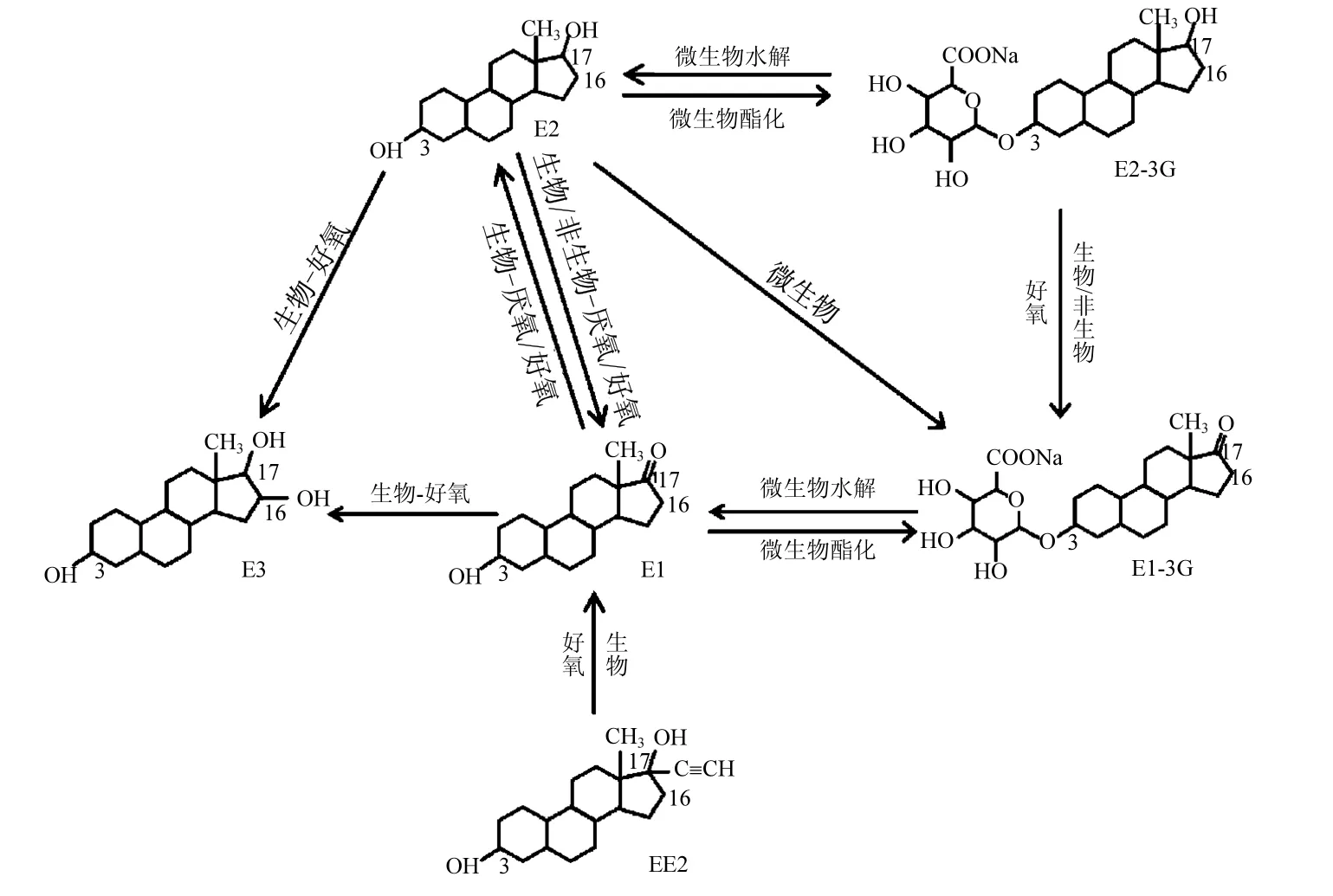
图2 SEs之间的相互转化与转化条件Fig.2 Transformation and the corresponding conditions among various SEs
很多研究表明,不同SEs组分之间会发生相互转化(图2).如E2与E1在生物降解过程中的相互转化或单向转化[83],同时,在E1和17α-E2的降解过程中发现了E3[78].此外,一些 SEs之间的相互转化也可以通过非生物过程实现.Fan等[82]研究证实E2可以通过非生物过程转化为一种未知的极性物质,但E2氧化为E1只能在生物作用下进行.而Colucci等[84]发现17β-E2先是被非生物途径氧化为E1,随后被微生物降解,说明E2转化为E1也可是非生物过程.Goeppert等[85]研究E2在土壤中的迁移转化发现,当有微生物存在时其降解产物主要为E1与E1-3S,无微生物存在时降解产物只有E1,首次证实了E2的迁移转化过程伴随E1-3S的形成,但对该过程的机理尚不明确,有待进一步研究.结合态SEs之间也会发生相互转化,Shrestha等[12]在研究E2-3G在农业土壤中的迁移转化时监测到E1-3G,说明E2-3G发生了氧化,但无法确定该过程是否是生物过程.
已经有学者发现,由于土壤及其有机组分的非均质性,吸附作用对SEs的生物利用度影响显著,且常常得到矛盾的结论.Casey等[86]研究不同来源的土壤对E2的吸附性和生物降解试验发现,吸附于固相的 SEs可以快速解吸到液相并被降解.Das等[87]研究SEs在分别填充了土壤、淡水沉积物和2种砂子的柱试验发现,较强的吸附作用没有阻碍生物降解.但是,也有学者发现吸附作用会导致SEs的生物可利用性明显降低,从而影响生物降解率.Fan等[88]精确模拟了E2在土壤中的迁移转化,E2需要以溶解态或从固相中解吸才能被生物利用.因此,胶体结合的 E2不能被微生物降解.Lee等[89]研究了E2在不同浓度HAs上的吸附,并利用E-screen Bioassay估算了E2的雌激素活性及其去除,发现随着HAs浓度的增加E2的吸附增强,但生物降解率及其转化成 E1的效率显著降低.这表明土壤吸附作用对SEs的生物降解作用的影响,需要结合试验土壤的吸附特性与微生物降解特性具体分析.
纵观SEs的降解/转化过程可以得出,SEs的代谢产物可能仍然具有内分泌干扰性;SEs代谢产物可能与母体发生竞争性吸附,从而有可能增加母体的迁移转化.
3.3 SEs在地下环境中的“穿透”过程
大部分室内实验认为,土壤介质对SEs具有较强的吸附作用,且土壤微生物对SEs的降解迅速,因此,SEs在包气带内的穿透能力有限,最终能进入地下水体的SEs只是少数.Fan等[90]研究E2在25cm土柱中的迁移规律时发现,土壤对E2吸附较强,约70%的E2被截留于土柱中,且主要截留在土柱表层5cm.这与批试验中土壤对E2有较强吸附能力结果是一致的.土壤有机质对SEs的截留作用更为显著,Larsen等[91]利用柱实验研究了17β-E2在砂土和富含有机质的粉质壤土中的迁移转换时发现,在粉质壤土中出水无 17β-E2,其主要被截留在土柱表层5cm内,而沙土中90%的17β-E2可穿透土柱,说明随着SOM的增加吸附作用增强,SEs移动性减小.
但在对实际场地的研究中发现,在施肥后的土壤与地下水中SEs含量很高,且长期存在,说明SEs在环境中具有一定的持久性.针对这种场地实验与室内实验研究结果相矛盾的现象,一些学者认为由于大部分室内实验所用土样破坏了土壤的天然结构,因此,没有考虑天然土壤结构中优先流对SEs迁移的影响.D'Alessio等[92]对比SEs在原状土与非原状土柱中的迁移转化发现,原状土中的根孔等大空隙的存在使 SEs与土壤的接触时间减少,促进了SEs的迁移.此外,土壤胶体的携带迁移也是导致包气带内 SEs迁移能力及持久性增强的另一主要原因. 例如,Thompson等[93]发现农业土壤中E2的移动性较强且能在土壤中长期存在,结果与许多室内实验相矛盾,推测这可能是土壤胶体促进了 E2在土壤中的迁移. Holbrook等[94]监测污水处理系统中SEs存在形态时发现,水中可有60%的E2与有机胶体结合;Yamamoto等[95]也发现河水中15%~30%的E2与DOM结合;龚剑等[96]研究了珠江2 条河流中E1的含量分布、胶体/水相间的分配作用,结果发现:珠江河水中约24%~26%的E1存在于胶体相.说明胶体对SEs具有较强的亲和力,从而增强其迁移能力.
可见,SEs会在各环境因素影响下随水体不断迁移,并进入底泥进一步穿透至地下水环境,扩大了其环境危害的范围,加大了其环境污染的风险.只有不断深入掌握SEs在环境介质中吸附、降解和迁移的特征及影响因素,才能有效控制其危害.
4 环境中SEs的危害控制措施
目前针对环境中 SEs治理主要集中于污水处理系统与水体的处理与去除,而针对畜禽粪便中 SEs的处理以及利用畜禽粪便施肥进入土壤系统后的修复措施研究很少.
4.1 水体中SEs的去除方法
目前针对水体中 SEs的去除方法主要有光降解、物理化学方法与微生物降解等.
4.1.1 光降解 SEs结构非常稳定,在自然环境下光降解的程度有限.关于SEs光降解的研究多数是基于紫外光(UV)等外加光源或有催化剂存在条件下的光催化降解.常用的催化剂有TiO2、Ti、Fe(III)等.Coleman等[97]在利用紫外光光照降解E2的实验中发现,在体系中加入Ti能显著提高 E2的光降解速率.Layton等[98]发现在紫外灯照射下,加入1g/L的TiO2能显著催化E2的光解,经过3h E2能完全矿化.马晓雁等[99]采用3种UV体系,即UV、UV/H2O2和UV/H2O2/TiO2降解水中E1、E2和EE2,结果表明,降解过程均符合一级反应动力学,单独 UV 系统中,E1降解效果良好,降解率高于80%,E2与EE2的降解率较差,低于40%;H2O2和催化剂TiO2的投加可提高3种SEs的降解率, UV/H2O2/TiO2系统中3种SEs的降解率均高于80%,且E1几乎完全降解.刘彬等[100]研究了在不同光源、光照强度与时间、pH、Fe3+等因素对水体中 EE2光降解的影响,发现紫外灯光照下的光降解速率比高压汞灯光照下的大,且在弱酸性条件下与 Fe3+的存在能促进 EE2光降解.Colucci等[84]研究了水环境中E1的光降解效率,并证实了Fe(III)对E1光降解的促进作用;通过对 E1的降解机理与途径进行研究发现,E1在光降解时破坏了苯环结构,生成了含有羟基的氧化产物.
4.1.2 物理-化学方法处理 (1)吸附:大多数SEs溶解度比较低,辛醇-水分配系数较高,因此在环境中易于从水相中分配到土壤/沉积物等固相中通过吸附和沉淀作用去除.水处理中常用的吸附剂有活性炭、活性污泥或失活污泥离子交换树脂、壳聚糖等有机物.Synder等[101]发现活性炭对E2的吸附能力很强,吸附去除率高于50%,且吸附去除率随 E2初始浓度的减少而降低.纪树兰等[102]研究了好氧活性污泥对E1、E2、EE2的吸附,40min达到吸附平衡,吸附率约为60%,且去除率随温度升高而降低.Yamamoto等[94]研究了SEs在多种吸附介质中的去除效率,发现 E2和EE2在单宁酸上的吸附最高,logKOC值分别为5.28和 5.22;在多糖酸上的吸附最弱,其 logKOC值分别为 2.62 和 2.53;而在腐殖酸上的 logKOC值一定程度上低于单宁酸;此外,进一步发现了SEs与含有苯环的物质具有较高的亲和力,这是由于π-电子之间的相互作用所致.
(2)膜分离:利用膜工艺去除水体SEs以被广泛研究与应用.Cartinella[103]用直接接触膜蒸馏和反渗透膜研究了废水中SEs去除特征,直接接触膜的去除效率较高且稳定,截留率大于 99.5%;反渗透膜的截留率介于 77%~99%,与实验持续时间和溶液中的化学成分有关.Yoon等[104]用纳滤膜和超滤膜研究了不同饮用水源水中 SEs的去除,对E1、E2、E3和EE2的平均截留率约为40%左右.Chang 等[105]研究了疏水性中空纤维膜对E1的去除效率, E1的去除率介于46%~95%.各种膜工艺对水体中SEs的去除率差别明显,这既与膜的种类、材质、孔径等特性有关,还与水体的物化性质如pH值、离子强度等有关.
(3)高级氧化法:高级氧化法技术种类繁多,目前研究多集中于氧化处理条件的优化、氧化降解动力学以及SEs降解途径3个方面的研究.常用的氧化剂有 O3、H2O2、NaClO、K2FeO4等.许多研究发现,将不同氧化剂进行优化组合后可显著提高SEs的去除率,例如H2O2/O3、UV/H2O2、UV/Fendon等.Huber等[106]研究了臭氧对EE2的氧化机理,发现臭氧能选择性的攻击官能团,EE2分子苯环上的1/2键与O3反应活性最高,反应速率快,其次是乙炔基,且降解反应的中间产物雌激素活性不及EE2的0.5%.Ternes等[107]研究了O3及O3/H2O2对地表水中EE2的降解,O3氧化时二级降解速率常数为7×109/(M·s),而O3/H2O2组合氧化时为 9.8×109/(M·s).Rosenfeldt等[108]研究了UV与UV/H2O2对E2和EE2的去除特性,发现在利用UV降解时加入15mg/L的H2O2后,雌激素去除率由20%增加到90%以上.
4.1.3 微生物降解法 利用微生物降解去除SEs研究相对较多.Khanal等[2]研究发现污水处理系统中的活性污泥吸附和生物降解可以降低污水中的雌激素,如对E2的去除率可达90%,但对E1的去除率较低,为25%~80%.Ternes[109]等研究了多种 SEs在污水处理厂的活性污泥好氧处理过程中的生物降解特征,24h后1mg/L的E1、E2降解均高于50%;EE2经过24h降解20%,说明EE2 相对稳定.Kjoholt等[110]在研究缺氧条件下活性污泥降解SEs的实验中发现,E1、E2和EE2的半衰期分别为 1.20h、2.01min和 4.13d,而在E1与E2共存的混合体系中,其半衰期为37.5min,介于两者单独降解时半衰期之间,其降解快慢顺序为:E2>E1>EE2,与好氧降解时一致.在此基础上,一些学者从环境样品与活性污泥中分离出了SEs高效降解菌,并对其代谢途径和影响因素进行了深入研究.Yoshimoto等[111]从污水处理厂分离得到了能够同时降解E1、E2、E3与EE2 的红球属菌株(Rhodococcus zopfii和 Rhodococcus equi).Xiong 等[112]从土壤中分离出了一株雌激素 高 效 降 解 菌 Comamonas testosterone ATCC11996,并通过分子生物学手段鉴定并分离出了羟化类固醇脱氢酶/碳酰还原酶的抑制子和活化子.杨俊等[113]从废水中分离出了一株对 E2具有高效降解能力的芽孢杆菌,对降解条件优化后其可在7d 内将初始浓度为50mg/L的E2完全降解.Yu等[114]从活性污泥中分离出 8株不同的E2的高效降解菌株,并对其降解特性进行了详细的研究.Zheng等[115]发现了一株以 E2为唯一碳源的降解菌株Pseudomonas aeruginosa TJ1,并在次基础上研究了吸附作用与生物作用对 E2 降解的影响.
4.2 土壤中SEs的去除方法
畜禽粪便通过堆肥或氧化塘过程可以自然降解 SEs. Zheng[83]等监测奶牛养殖场粪便的降解过程时发现,新鲜牛粪经过 3个月堆肥处理后,SEs由2100μg/kg降低到160μg/kg,同时监测氧化塘中SEs降解特征时发现,在第1氧化塘经过26h左右停留后SEs由26μg/L降低到450ng/Ll;经过第3氧化塘后低于检出限.说明堆肥处理与氧化塘能有效去除畜禽粪尿中的SEs.Furuichi等[28]利用厌氧处理和滴流生物滤池好氧处理组合工艺对养猪废水中SEs,去除效率可达90%以上,其中滴流生物滤池起关键作用,且对 17β-E2 和E1 的去除率优于17-αE2 和E3.Shappell等[116]基于湿地处理系统去除养猪粪便废液中的 E1、E2 和E3,去除率分别为86%、46%和59%,在此基础上将湿地处理与氧化塘相结合,SEs总去除率超过 80%.张真[117]利用污水土地处理系统-土壤净化槽技术对农村污水中典型 SEs的去除效果进行了研究,E1、E2 和 E3平均去除率均能达到90%以上,EE2平均去除率为70%.虽然这些新处理技术能有效的去除畜禽粪便与土壤中的SEs,但仍不能处理完全,且还会产生二次污染的可能.
5 研究展望
5.1 对SEs的环境行为的研究主要集中在游离态,而针对结合态雌激素环境行为的研究几乎空白.虽然结合态雌激素对生物的内分泌干扰性较低,但它在环境微生物作用下易转化成游离态而重获雌激素活性,其潜在污染风险不可忽略.
5.2 目前针对污水处理系统中SEs的迁移转化与去除研究日趋成熟,而对其主要环境来源——畜禽粪便中的 SEs及其在农田土壤与地下水环境中的迁移转换以及污染修复等研究相对薄弱.
5.3 由于对SEs在土壤中多种吸附过程的研究不够深入和系统,未能深入阐明其吸附机制;此外,缺乏多 SEs溶质体系下环境行为研究,使得对SEs在土壤中的吸附与降解研究以实验现象解释为主,未能深入揭示其机理.
5.4 虽然针对SEs在土壤中的迁移转化研究取得一定进展,但缺乏反映场地实际条件,如不同岩性组成的界面效应、降雨与灌溉影响下的干湿交替补给方式、包气带与毛细带特征等影响下SEs在包气带与地下水含水层系统的穿透机制.
[1] Liu R, Zhou J L, Wilding A. Simultaneous determination of endocrine disrupting phenolic compounds and steroids in water by solid phase extraction gas-chromatography-mass spectrometry [J]. J. Chromatogr. A, 2004,1022(1/2):179-189.
[2] Khanal S K, Xie B, Thompson M L, et al. Fate, transport and biodegradation of natural estrogens in the environment and engineered systems [J]. Environmental Science and Technology,2006,40(21):6537-6546.
[3] Wilson V S, Lambright C, Ostby J, et al. In vitro and in vivo effects of 17β- trenbolone: a feedlot effluent contaminant [J]. Toxicol. Sci., 2002,70:202-211.
[4] 刘姝芳,李艳霞,张雪莲,等.东北三省畜禽养殖类固醇激素排放及其潜在污染风险 [J]. 环境科学, 2013,34(8):3180-3187.
[5] Zuo Y G, Zhang K, Deng Y W. Occurrence and photochemicaldegradation of 17α-ethinylestradiol in Acushernet River estuary[J]. Chemosphere, 2006,63:1583-1590.
[6] 李晓曼,黄 斌,孙雯雯,等.类固醇雌激素环境行为研究进展[J]. 环境化学, 2014,33(8):1276-1286.
[7] Young W F, Whitehouse P, Johnson I, et al. Proposed predicted no effect concentrations (PNECs) for natural and synthetic steroid oestrogens in surface waters [M]. Environment Agency, 2002.
[8] Raman D R, Williams E L, Layton A C, et al. Estrogen Content of Dairy and Swine Wastes [J]. Environmental Science & Technology, 2004,38(13):3567-3573.
[9] Johnson A C, Williams R J, Matthiessen P. The potential steroid hormone contribution of farm animals to freshwaters, the United Kingdom as a case study [J]. Science of the Total Environment,2006,362(1-3):166-178.
[10] Zheng W, Li X, Yates S R, et al. Anaerobic transformation kinetics and mechanism of steroid estrogenic hormones in dairy lagoon water [J]. Environmental Science & Technology, 2012, 46(10):5471-5478.
[11] Liu Z H, Kanjo Y, Mizutani S. Urinary excretion rates of natural estrogens and androgens from humans, and their occurrence and fate in the environment: A review [J]. Sci. Total. Environ., 2009,407(18):4975-4985.
[12] Shrestha S L, Casey F X, Hakk H, et al. Fate and transformation of an estrogen conjugate and its metabolites in agricultural soils[J]. Environmental Science & Technology, 2012,46(20):11047-11053.
[13] Adler P, Steger-Hartmann T, Kalbfus W. Distribution of natural and synthetic estrogenic steroid hormones in water samples from Southern and Middle Germany [J]. Acta Hydrochimica et Hydrobiologica, 2001,29(4):227-241.
[14] Hoffmann B, dePinho T G, Schuler G. Determination of free and conjugated oestrogens in peripheral blood plasma, feces and urine of cattle throughout pregnancy [J]. Experimental and Clinical Endocrinology & Diabetes, 1997,105(5):296-303.
[15] LiuZ H, KanjoY, Mizutani S.Urinary excretion rates of natural estrogens and androgens from humans,and their occurrence and fate in the environment: A review [J]. Sci. Total Environ., 2009,407(18):4975-4985.
[16] Sophie D L, David L J. Biodegradation of estrone and 17b-estradiol in grassland soils amended with animal wastes [J]. Soil Biology & Bioehemistry, 2006,38:2803-2815.
[17] Farrell M, Jones D L. Critical evaluation of municipal solid waste composting and potential compost markets [J]. Bioresource Technology, 2009,100:4301-4310.
[18] Hobe G, Schon R, Goneharov N, et al. Some new aspects of 17a-estradiol metabolism in man [J]. Steroids, 2002,67(11):883-893.
[19] Kolpin D W, Furlong E T, Meyer M T, et al. Pharmaceuticals,hormones, and other organic wastewater contaminants in US streams, 1999~2000: A national reconnaissance [J]. Environmental Science & Technology, 2002,36(6):1202-1211.
[20] Tabata A, Kashiwada S, Ohnishi Y, et al. Estrogenic influences of estradiol-17b, p-nonylphenol and bis-phenol-A on Japanese Medaka (Oryzias latipes) at detected environmental concentrations [J]. Water Science and Technology, 2001,43(2):109-116.
[21] Shore L S, Shemesh M, Cohen R. The role of oestradiol and oestrone in chicken manure silage in hyperoestrogenism in cattle[J]. Australian Veterinary Journal, 1988,65(2):68-68.
[22] Finlay-Moore O, Hartel P G, Cabrera M L. 17β-estradiol and testosterone in soil and runoff from grasslands amended with broiler litter [J]. Journal of Environmental Quality, 2000,29(5):1604-1611.
[23] Peterson E W, Davis R K , Orndorff H A. 17β- estradiol as an indicator of animal waste contamination in mantled karst aquifers[J]. J. Environ. Qual., 2000,29:826-834.
[24] Kuch H M, Ballschmiter K. Determination of endocrine disrupting phenolic compounds and estrogens in surface and drinking water by HRGC-(NCI)-MS in the picogram per liter range [J]. Environ. Sci. Technol., 2001,35(15):3201-3206.
[25] Roefer P, Snyder S, Zegers R E, et al. Endocrine-disrupting chemicals in a source water [J]. American Water Works Association Journal, 2000,92(8):52.
[26] Hutchins S R, White M V, Hudson F M, et al. Analysis of lagoon samples from different concentrated animal feeding operations for estrogens and estrogen conjugates [J]. Environmental Science & Technology, 2007,41(3):738-744.
[27] Kjær J, Olsen P, Bach K, et al. Leaching of estrogenic hormones from manure-treated structured soils [J]. Environmental Science & Technology, 2007,41(11):3911-3917.
[28] Furuichi T, Kannan K, Suzuki K, et al. Occurrence of estrogenic compounds in and removal by a swine farm waste treatment plant[J]. Environmental Science & Technology, 2006,40(24):7896-7902.
[29] Sarmah A K, Northcott G L, Leusch F D L, et al. A survey of endocrine disrupting chemicals (EDCs) in municipal sewage and animal waste effluents in the Waikato region of New Zealand [J]. Science of the Total Environment, 2006,355(1):135-144.
[30] Clara M, Kreuzinger N, Strenn B, et al. The solids retention time—a suitable design parameter to evaluate the capacity of wastewater treatment plants to remove micropollutants [J]. Water Research, 2005,39(1):97-106.
[31] Andersen H, Siegrist H, Halling-Sørensen B, et al. Fate of estrogens in a municipal sewage treatment plant [J]. Environmental Science & Technology, 2003,37(18):4021-4026.
[32] Angus R A, Stanko J, Jenkins R L, et al. Effects of 17αethynylestradiol on sexual development of male western mosquitofish (Gambusia affinis) [J]. Comparative Biochemistryand Physiology Part C: Toxicology & Pharmacology, 2005,140(3):330-339.
[33] Lee H B, Peart T E, Chan J, et al. Occurrence of endocrinedisrupting chemicals in sewage and sludge samples in Toronto,Canada [J]. Water Quality Research Journal of Canada, 2004,39(1):57-63.
[34] Nakada N, Tanishima T, Shinohara H, et al. Pharmaceutical chemicals and endocrine disrupters in municipal wastewater in Tokyo and their removal during activated sludge treatment [J]. Water Research, 2006,40(17):3297-3303.
[35] Johnson A C, Belfroid A, Di Corcia A. Estimating steroid oestrogen inputs into activated sludge treatment works and observations on their removal from the effluent [J]. Science of the Total Environment, 2000,256(2):163-173.
[36] Prietoa A, Vallejoa A, Zuloaga O, et al. Selective determination of estrogenic compounds in water by microextraction by packed sorbents and a molecularly imprinted polymer coupled with large volume injection-in-port-derivatization gas chromatographymass spectrometry [J]. Analytica Chimica Acta, 2011,703:41-51.
[37] Vulliet E, Wiest L, Baudot R, et al. Multi-residue analysis of steroids at sub-ng/L levels in surface and ground-waters using liquid chromatography coupled to tandem mass spectrometry [J]. J. Chromatogr. A, 2008,1210(1):84-91.
[38] Cathurn S, Sabik H. Determination of steroids and coprostanol in surface water, effluent and mussel using gas chromatographymass spectrometry [J]. Chromatographia, 2001,53:394-399.
[39] Velicu M, Suri R. Presence of steroid hormones and antibiotics in surface water of agricultural, suburban and mixed-use areas [J]. Environ. Monit. Assess, 2009,154(1/4):349-359.
[40] Isobe T, Shiraishi H, Yasuda M, et al. Determination of estrogens and their conjugates in water using solid-phase extraction followed by liquid chromatography-tandemmass spectrometry [J]. J. Chromatogr. A, 2003,984(1/2):195-202.
[41] Laganà A, Bacaloni A, Leva I D, et al. Analytical methodologies for determining the occurrence of endocrine disrupting chemicals in sewage treatment plants and natural waters [J]. Anal. Chim. Acta, 2004,501(1):79-88.
[42] Grovera D P, Zhou J L, Frickers P E, et al. Improved removal of estrogenic and pharmaceutical compounds in sewage effluent by full scale granular activated carbon: Impact on receiving river water [J]. J. Hazard. Mat., 2011,185:1005-1011.
[43] Lei B L, Huang S B, Zhou Y Q, et al. Levels of six estrogens in water and sediment from three rivers in Tianjin area, China [J]. Chemosphere, 2009,76(1):36-42.
[44] Wang L, Ying G G, Chen F, et al. Monitoring of selected estrogenic compounds and estrogenic activity in surface water and sediment of the Yellow River in China using combined chemical and biological tools [J]. Environ. Pollut., 2012,165:241-249.
[45] Beck J, Totsche K U, Kögel-Knabner I. A rapid and efficient determination of natural estrogens in soils by pressurised liquid extraction and gas chromatography—mass spectrometry [J]. Chemosphere, 2008,71(5):954-960.
[46] 韩 伟.奶牛及肉牛雌激素的排放及其环境迁移特征 [D]. 北京:北京师范大学, 2010:1-2.
[47] Huang B, Wang B, Ren D, et al. Occurrence, removal and bioaccumulation of steroid estrogens in Dianchi Lake catchment,China [J]. Environ. Int., 2013,59:262-273.
[48] Labadie P, Hill E M. Analysis of estrogens in river sediments by liquid chromatography-electrospray ionisation mass spectrometry comparison of tandem mass spectrometry and time-of-flight mass spectrometry [J]. J. Chromatogr. A, 2007,1141(2):174-181.
[49] Stanford B D, Weinberg H S. Isotope dilution for quantitation of steroid estrogens and nonylphenols by gas chromatography with tandem mass spectrometry in septic, soil, and groundwater matrices [J]. J. Chromatogr. A, 2007,1176(1/2):26-36.
[50] Hohenblum P, Gans O, Moche W, et al. Monitoring of selected estrogenic hormones and industrial chemicals in groundwaters and surface waters in Austria [J]. Science of the Total Environment, 2004,333(1):185-193.
[51] Swartz C H, Reddy S, Benotti M J, et al. Steroid estrogens,nonylphenol ethoxylate metabolites, and other wastewater contaminants in groundwater affected by a residential septic system on Cape Cod, MA [J]. Environ. Sci. Technol., 2006,40(16):4894-4902.
[52] Mansilha C, Melo A, Ferreira I M P L, et al. Groundwater from Infiltration Galleries Used for Small Public Water Supply Systems: Contamination with Pesticides and Endocrine Disruptors [J]. B Environ. Contam. Tox., 2011,87(3):312-318.
[53] Purdom C E, Hardiman P A, Bye V V J, et al. Estrogenic effects of effluents from sewage treatment works [J]. Chemistry and Ecology, 1994,8(4):275-285.
[54] Nimrod A C, Benson W H. Reproduction and development of Japanese medaka following an early life stage exposure to xenoestrogens [J]. Aquatic Toxicology, 1998,44(1):141-156.
[55] Biegel L B, Flaws J A, Hirshfield A N, et al. 90-day feeding and one-generation reproduction study in Crl: CD BR rats with 17β-estradiol [J]. Toxicological Sciences, 1998,44(2):116-142.
[56] Korsgaard B, Andreassen T K, Rasmussen T H. Effects of an environmental estrogen, 17α-EE2, on the maternal-fetal trophic relationship in the eelpout Zoarces viviparous [J]. Marine Environmental Research, 2002,54(3):735-739.
[57] 戴璇颖,徐世清.环境激素对生物的影响及其预防措施 [J]. 四川环境, 2003,22(6):13-16.
[58] Cargouet M, Perdiz D, Mouatassim-Souali A, et al. Assessment of river contamination by estrogenic compounds in Paris area(France) [J]. Science of the Total Environment, 2004,324(1):55-66.
[59] Brown R J, Conradi M, Depledge M H. Long-term exposure to 4-nonylphenol affects sexual differentiation and growth of the amphipod Corophium volutator (Pallas, 1766) [J]. Sci. Total Environ., 1999,223(1-3):77-88.
[60] Ternes T A, Stumpf M, Mueller J, et al. Behavior and occurrence of estrogensin municipal sewage treatment plants:I. Investigations in Germany, Canada and Brazil [J]. The Science of the Total Environment, 1999,225(1/2):81-90.
[61] Wicks C, Kelley C, Peterson E. Estrogen in a karstic aquifer [J]. Ground Water, 2004,42(3):384-389.
[62] Labadie P, Cundy A B, Stone K, et al. Evidence for the migration of steroidal estrogens through river bed sediments [J]. Environmental Science & Technology, 2007,41(12):4299-4304.
[63] Lee L S, Strock T J, Sarmah A K, et al. Sorption and dissipation of testosterone, estrogens, and their primary transformation products in soils and sediment [J]. Environmental Science & Technology, 2003,37(18):4098-4105.
[64] 李建中.典型内分泌干扰物在土壤中迁移转化规律研究 [D].北京:清华大学, 2013.
[65] Van Emmerik T, Angove M J, Johnson B B, et al. Sorption of 17β-estradiol onto selected soil minerals [J]. Journal of Colloid and Interface Science, 2003,266(1):33-39.
[66] Shareef A, Angove M J, Wells J D, et al. Sorption of bisphenol A,17α-ethynylestradiol and estrone to mineral surfaces [J]. Journal of Colloid and Interface Science, 2006,297(1):62-69.
[67] 马伟芳,陈 斌,曾凡刚,等.17β-雌二醇和炔雌醇在土壤中的吸附特性研究 [J]. 环境工程, 2014,32(9):109-114.
[68] Ren Y X, Nakano K ,Nomura M ,et al. A thermodynamic analysis on adsorption of estrogens in activated sludge process [J]. Water Research, 2007,41(11):2341-2348.
[69] 岳 波,靳 青,黄泽春,等.雌酮(E1)在土壤中的吸附特性 [J].环境科学研究, 2013,26(2):208-213.
[70] Francis X M, CaseY, Gerald L L, et al. Fate and transport of 17βestradiol in soil- water systems [J]. Environ. Sci. Technol, 2003,37:2400-2409.
[71] Lai K M, Johnson K L, Scrimshaw M D, et al. Binding of waterborne steroid estrogens to solid phases in river and estuarine systems [J]. Environmental Science & Technology, 2000,34(18):3890-3894.
[72] Takigami H, Taniguchi N, Shimizu Y. Sorption and desorption of 17beta-estradiol to natural sediment [J]. Water. Sci. Technol.,2011,64(7):1473-1478.
[73] Bedard M, Giffear K A, Ponton L, et al. Characterization of binding between 17β-estradiol and estriol with humic acid via NMR and biochemical Analysis [J]. Biophysical Chemistry, 2014,189:1-7.
[74] Diana L D L, Rudolf J S, Valdemar I E. Sorption behavior of EE2 on soils subjected to different long-termorganic amendments [J]. Science of the Total Environment, 2012,23:120-124.
[75] Yamamoto H, Liljestrand H M, Shimizu Y, et al. Effects of physical-chemical characteristics on the sorption of selected endocrine disruptors by dissolved organic matter surrogates [J]. Environmental Science & Technology, 2003,37(12):2646-2657.
[76] 姜 鲁,王继华,李建忠,等.炔雌醇和壬基酚在土壤中的吸附-吸特征 [J]. 环境科学, 2012,33(11):3885-3892.
[77] Combalbert S, Hernandez-Raquet G. Occurrence, fate, and biodegradation of estrogens in sewage and manure [J]. Appl. Microbiol. Biotechnol, 2010,86:1671-1692.
[78] Xuan R, Blassengale A A, Wang Q. Degradation of estrogenic hormones in a silt loam soil [J]. Journal of Agricultural and Food Chemistry, 2008,56(19):9152-9158.
[79] Ying G G, Kookana R S, Dillon P. Sorption and degradation of selected five endocrine disrupting chemicals in aquifer material[J]. Water Research, 2003,37:3785-3791.
[80] Peck M, Gibson R W, Kortenkamp A, et al. Sediments are major sinks of steroidal estrogens in two United Kingdom rivers [J]. Environmental Toxicology & Chemistry, 2004,23:945-952.
[81] Colucci M S, Topp E. Persistence of estrogenic hormones in agricultural soils: II. 17alpha-ethynylestradiol [J]. J. Environ. Qual., 2001,30(6):2077-2080.
[82] Fan Z, Casey F X M, Hakk H, et al. Persistence and fate of 17β-estradiol and testosterone in agricultural soils [J]. Chemosphere, 2007,67(5):886-895.
[83] Zheng W, Yates S R, Bradford S A. Analysis of steroid hormones in a typical airy waste disposal system [J]. Environ. Sci. Technol.,2008,42(2):530-535.
[84] Colucci M S. Topp E. Persistence of estrogenic hormones in agricultural soils: I. 17β- estradiol and estrone [J]. J. Environ. Qual., 2001,30:2070-2076.
[85] Goeppert N, Dror I, Berkowitz B. Detection, fate and transport of estrogen family hormones in soil [J]. Chemosphere, 2014,95:336-345.
[86] Casey F X M, Larsen G L, Hakk H, et al. Fate and Transport of 17β-Estradiol in Soil-Water Systems [J]. Environ. Sci. Technol.,2003,37(11):2400-2409.
[87] Das B S, Lee L S, Rao P, et al. Sorption and degradation of steroid hormones in soils during transport: Column studies and model evaluation [J]. Environ. Sci. Technol., 2004,38(5):1460-1470.
[88] Fan Z, Casey F X M, Hakk H, et al. Discerning and modeling the fate and transport of testosterone in undisturbed soil [J]. Journal of Environmental Quality, 2007,36(3):864-873.
[89] Lee J H, Zhou J L, Kim S D. Effects of biodegradation and sorption by humic acid on the estrogenicity of 17β-estradiol [J]. Chemosphere, 2011,85(8):1383-1389.
[90] Fan Z S, Casey F, Hakk H, et al. Modeling coupled degradation,sorption, and transport of 17beta-estradiol in undisturbed soil A-2135-2010 [J]. Water Resour. Res., 2008,44(W084248).
[91] LARSEN G, CASEY F, MAGELKY B, et al. Second International Conference on Pharmaceuticals and Endocrine Disrupting Chemicals in Water [R]. October 9-11, Minneapolis,MN, 2001.
[92] D'Alessio M, Vasudevan D, Lichwa J, et al. Fate and transport of selected estrogen compounds in Hawaii soils: Effect of soil type and macropores [J]. Journal of Contaminant Hydrology, 2014,166 1-10.
[93] Thompson M L, Casey F X M, Khan E, et al. Occurrence and pathways of manure-borne 17β-estradiol in vadose zone water[J]. Chemosphere, 2009,76(4):472-479.
[94] Holbrook R D, Love N G, Novak J T. Sorption of 17β-estradiol and 17α-ethinylestradiol by colloidal organic carbon derived from biological wastewater treatment systems [J]. Environmental Science & Technology, 2004,38(12):3322-3329.
[95] Yamamoto H, Liljestrand H. The fate of estrogenic compounds in the aquatic environment: sorption onto organic colloids [J]. Water Science & Technology, 2003,47(9):77-84.
[96] 龚 剑,黄 文,杨 娟,等.珠江河流胶体中的典型内分泌干扰物 [J]. 中国环境科学, 2011,31(11):1904-1909.
[97] Coleman M, Eggins R, Byrne J, et al. Photocatalytic Degradation of 17β-estradiol onimmobilized Ti O2[J]. Applied Catalysis B:Environmental, 2000,24(2):L1-L5.
[98] Layton A. C, Gregory B. W, Seward J. R, et al. Mineralization of steroidal hormones by biosolids in waste water treatment systems in Tennessee USA [J]. Environmental Science & Technology,2000,34(18):3925-3931.
[99] 马晓雁,倪梦婷,倪永炯,等.UV体系中3种微量类固醇雌激素的竞争降解及同趋转化 [J]. 中国环境科学, 2014,34(4):904-911.
[100] 刘 彬,刘先利,吴 峰,等.水溶液中 17α-乙炔基雌二醇的光降解 [J]. 环境科学学报, 2003,23(4):508-511.
[101] Snyder S A, Westerhoff P, Yoon Y, et al. Pharmaceuticals,personal care products, and endocrine disruptors in water:implications for the water industry [J]. Environmental Engineering Science, 2003,20(5):449-469.
[102] 纪树兰,杨媛媛,秦振平,等.好氧颗粒污泥等温吸附甾体雌激素[J]. 北京工业大学学报, 2009,(11):1537-1542.
[103] Cartinella J L, Cath T Y, Flynn M T, et al. Removal of natural steroid hormones from wastewater using membrane contactor processes [J]. Environmental Science & Technology, 2006,40(23):7381-7386.
[104] Yoon Y, Westerhoff P, Snyder S A, et al. Removal of endocrine disrupting compounds and pharmaceuticals by nanofiltration and ultrafiltration membranes [J]. Desalination, 2007,202(1):16-23.
[105] Chang S, Waite T D, Schäfer A I, et al. Adsorption of the endocrine-active compound estrone on microfiltration hollow fiber membranes [J]. Environmental Science & Technology, 2003,37(14):3158-3163.
[106] Huber M M, Ternes T A, Von Gunten U. Removal of estrogenic activity and formation of oxidation products during ozonation of 17α-ethinylestradiol [J]. Environmental Science & Technology,2004,38(19):5177-5186.
[107] Ternes T A, Stüber J, Herrmann N, et al. Ozonation: a tool for removal of pharmaceuticals, contrast media and musk fragrances from wastewater [J]. Water Research, 2003,37(8):1976-1982.
[108] Rosenfeldt E J, Linden K G. Degradation of endocrine disrupting chemicals bisphenol A, ethinyl estradiol, and estradiol during UV photolysis and advanced oxidation processes [J]. Environmental Science & Technology, 2004,38(20):5476-5483.
[109] Ternes T A, Kreckel P, Mueller J. Behaviour and occurrence of estrogens in municipal sewage treatment plants—II. Aerobic batch experiments with activated sludge [J]. Science of the Total Environment, 1999,225(1):91-99.
[110] Kjølholt J. Degradation of estrogens in sewage treatment processes [M]. Danish Environmental Protection Agency, 2004.
[111] Yoshimoto T, Nagai F, Fujimoto J, et al. Degradation of estrogens by Rhodococcus zopfii and Rhodococcus equi isolates from activated sludge in wastewater treatment plants [J]. Appl. Environ. Microbiol., 2004,68(4):2057-2060.
[112] Xiong G M, Draus E, Luo Y, et al. 3α-hydroxysteroid dehydorgenase/carbonyl reductase as a tool for isolation and characterization of a new marine steroid degrading bacterial strain[J]. Chemico-Biological Interactions, 2009,178:206-210.
[113] 杨 俊,姜理英,陈建孟.1株17β-雌二醇高效降解菌的分离鉴定及降解特性 [J]. 环境科学, 2010,31(5):1313-1319.
[114] Yu C P, Roh H, Chu K H. 17β-Estradiol-degrading bacteria isolated from activated sludge [J]. Environ. Sci. Technol.,2007,41(2):486-492.
[115] Zeng Q, Li Y, Gu G, et al. Sorption and biodegradation of 17β-estradiol by acclimated aerobic activated sludge and isolation of the bacterial strain [J]. Environmental Engineering Science, 2009,26(4):783-790.
[116] Shappell N W, Billey L O, Forbes D, et al. Estrogenic activity and steroid hormones in swine wastewater through a lagoon constructedwetland system [J]. Environ. Sci. Technol., 2007,41:444-450.
[117] 张 真.14C-BPA 及雌激素在污水土地处理系统中吸附降解研究 [D]. 上海:上海交通大学, 2013.
Fate and ecological regulation of steroidal estrogens in subsurface environment.
SONG Xiao-ming1, YANG Yue-suo1,2*, WEN Yu-juan1, M. Adeel1, WANG Yuan-yuan1, YANG Xin-yao1(1.Key Laboratory of Regional Environment and Eco-restoration, Ministry of Education, Shenyang University, Shenyang 110044, China;2.College of Environment and recourses, Changchun 130012, China). China Environmental Scinence, 2016,36(9):2828~2840
This paper reviewed the sources, hazard and environmental fate of typical steroidal estrogens, both conjugate and free phases, in environment. The migration and transformation processes of steroidal estrogens through soil and shallow groundwater system, such as sorption and biodegradation, were thoroughly reviewed. The most popular treatment technologies and risk management practices were also critically summarized. Finally, based on current studies on the penetration and ecological impact of steroidal estrogens in vadose zone and shallow groundwater system, the perspectives of future research was proposed.
steroidal estrogens;subsurface environment;sorption;microbial degradation;fate and transport
X171.5
A
1000-6923(2016)09-2828-13
2016-01-05
国家自然科学基金项目(41272255,41472237);辽宁省创新团队项目(LT201502);沈阳市科技计划项目(F14-133-9-00, F15-113-9-00)
* 责任作者, 教授, YangYuesuo@jlu.edu.cn
宋晓明(1985-),男,吉林柳河人,沈阳大学环境学院博士研究生,主要从事有机污染物在环境中的迁移转化及污染场地生态修复等研究.
